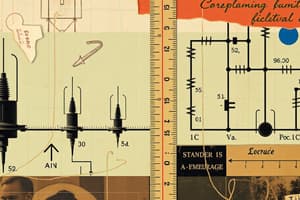Podcast
Questions and Answers
What is the relationship between watts, voltage, and amperage?
What is the relationship between watts, voltage, and amperage?
- Voltage is the product of watts and amperage.
- Amperage is the product of watts and voltage.
- Watts equals the difference between voltage and amperage.
- Watts is the product of amperage and voltage. (correct)
Why must the voltage of a device match the voltage of the outlet?
Why must the voltage of a device match the voltage of the outlet?
- To maximize the amperage flowing through the circuit.
- To improve the speed of electricity transmission.
- To decrease the energy consumption of the device.
- To ensure the device operates correctly and safely. (correct)
What does one kilowatt-hour (kWh) represent?
What does one kilowatt-hour (kWh) represent?
- Energy usage of 1000 watts over a year.
- Power usage of 1000 watts for one hour. (correct)
- Energy consumption of 100 watts for ten hours.
- Power supply of 1 watt for one hour.
How is the capacity of a power bank measured?
How is the capacity of a power bank measured?
What does a higher amperage in a circuit signify?
What does a higher amperage in a circuit signify?
Which of the following statements about Greenfield's power station is true?
Which of the following statements about Greenfield's power station is true?
What kind of wiring is needed for higher voltage systems?
What kind of wiring is needed for higher voltage systems?
If a device uses 600 watts for one hour, how many kilowatt-hours does it consume?
If a device uses 600 watts for one hour, how many kilowatt-hours does it consume?
Flashcards
Voltage
Voltage
The force or pressure that pushes electricity through a circuit. Think of it as the strength of the electrical push.
Amperage
Amperage
The amount of electricity flowing through a circuit at any given time. It's like the number of 'Lego pieces' of electricity moving through the circuit.
Kilowatt-hour (kWh)
Kilowatt-hour (kWh)
A unit of energy consumption that measures how much power is used over a specific time. It's like a measure of how many 'Lego pieces' of electricity are used over a certain period.
Watts
Watts
Signup and view all the flashcards
Milliamp-hours (mAh)
Milliamp-hours (mAh)
Signup and view all the flashcards
Greenfield Power Station
Greenfield Power Station
Signup and view all the flashcards
Electrical Compatibility
Electrical Compatibility
Signup and view all the flashcards
Voltage and Wiring Thickness
Voltage and Wiring Thickness
Signup and view all the flashcards
Study Notes
Electricity: Voltage and Amperage
- Voltage is the force or pressure that pushes electricity through a device or a circuit.
- A higher voltage means a stronger push, similar to how harder you push on a bicycle pedal, the faster it goes.
- Amperage is the amount of electricity flowing through a circuit at any given time.
- Imagine it as the number of "Lego pieces" of electricity flowing through the circuit.
- Watts (power) is calculated by multiplying voltage and amperage (watts = volts x amps).
- Higher amperage means more electricity is flowing through the circuit, similar to pushing more Lego pieces through the circuit.
Electrical Compatibility
- The voltage of a device must match the voltage of the outlet it's plugged into.
- For example, a device designed for 220-240 volts can't be used on a 110-volt outlet.
- In the Philippines, standard voltage is 220-240 volts, while in the United States, it's 110-120 volts.
- This difference in voltage influences the size and thickness of electrical wiring needed for homes and buildings.
- Higher voltage requires thicker wiring to handle the stronger electrical push.
Understanding Kilowatt-Hours
- Kilowatt-hour (kWh) is a unit of energy consumption.
- It represents the amount of power used over a specific time.
- One kilowatt-hour equals using 1000 watts for one hour.
- Electricity bills often measure consumption in kilowatt-hours.
- The electrical power needed for an appliance or device is measured in watts.
- Example: A vacuum cleaner with 600 watts running for one hour consumes 600 watt-hours or 0.6 kilowatt-hours.
Power Banks and Milliamp-Hours
- Power banks are often rated in milliamp-hours (mAh).
- A 10,000mAh power bank can store enough electricity to power a device for a certain amount of time.
- The power bank's capacity is the amount of energy it can store, similar to the amount of Lego pieces held in the power station.
- Milliamp-hours (mAh) are a measure of electrical charge, while watts are a measure of power.
Greenfield Power Station
- Greenfield's power station is a portable generator.
- It can be used to power essential appliances like electric fans and modems during power outages.
- The power station has a maximum output of 800 watts.
- It can be charged using solar panels, wall outlets, or USB connections.
Summary
- Voltage, amperage, and watts are crucial concepts for understanding electricity.
- Voltage represents the force or pressure that pushes electricity, while amperage represents the amount of electricity flowing through a circuit.
- Watts represent the rate at which energy is consumed or used, while kilowatt-hours measure total energy consumption over time.
- Power banks store energy and release it to power devices when needed.
- Greenfield's power station provides convenient power during outages.
Studying That Suits You
Use AI to generate personalized quizzes and flashcards to suit your learning preferences.




